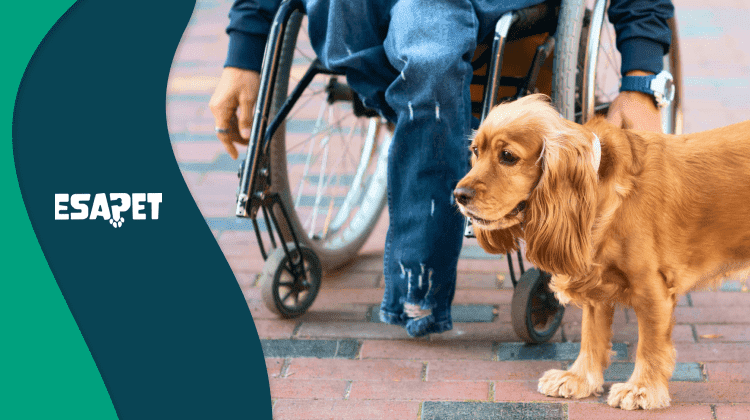What Disabilities Qualify for a Service Dog: Eligibility and Benefits

Service dogs are incredible companions for individuals with disabilities. These trained animals perform tasks that make daily life easier. They guide visually impaired individuals and retrieve dropped items. They also alert someone to an oncoming medical emergency, offering support.
Service dogs provide more than just practical help. They help manage tasks and comfort people in stressful situations. Their role improves the quality of life and gives greater freedom. Keep reading to learn about service animals and what disabilities qualify for a service dog!
Introduction to Service Dogs and Their Legal Rights
Service dogs are trained to help individuals. They perform tasks such as guiding, retrieving objects, and alerting to medical conditions. They allow people with disabilities to live more independently. Their tasks are tailored to the individual’s needs based on their disability.
The Americans with Disabilities Act (ADA) grants service dogs access to public places. Businesses cannot require documentation or deny access based on the dog’s breed. They may only ask what tasks the dog is trained to perform for the handler.
What Are Service Dogs?
Service dogs are animals trained to perform tasks that help individuals with physical or mental illness. These tasks include retrieving objects, opening doors, or alerting to medical emergencies. They help individuals to manage daily activities and enhance their quality of life.
Service dogs offer practical assistance and emotional support. They help people with disabilities perform tasks that might otherwise be impossible. Each service dog is trained to meet the specific needs of its handler.
Understanding the ADA and Service Dog Qualifications
The Americans with Disabilities Act (ADA) recently changed. It protects individuals using service dogs under Title II and Title III. Title II covers state and local government services. In contrast, Title III pertains to public accommodations and commercial facilities.
The ADA recognizes only dogs as service animals. These dogs must be trained to perform tasks for individuals with disabilities. To qualify for a service dog, an individual must have a documented disability that limits major life activities.
The service dog must perform tasks directly related to the person’s disability. Under Title II and Title III, entities must allow service dogs in public places. They can go with their owners in areas open to the public. This includes spaces like restaurants, hospitals, and stores.
Eligible Psychiatric Disabilities for a Service Dog
To qualify for a Psychiatric Service Dog (PSD), a person must have a psychiatric disability that impacts their daily life. Conditions like PTSD, anxiety disorders, bipolar disorder, and OCD are common reasons someone might benefit from a PSD. These dogs help by alerting handlers to panic attacks or help with grounding during anxiety episodes.
PSDs perform tasks that directly relate to these conditions. They provide stability and support when symptoms become overwhelming. Here’s how they can help in each condition:
Post-Traumatic Stress Disorder (PTSD)
Individuals with PTSD often experience flashbacks, panic attacks, and hypervigilance. A PSD provides deep pressure therapy during an episode. They can also detect rising anxiety, guide individuals to a safe space, or calm them in overwhelming situations.
Anxiety Disorders
For individuals with severe anxiety disorders, PSDs are trained to recognize the signs of a panic attack. They respond with physical pressure or guide the handler away from stressful environments.
Bipolar Disorder
PSDs assist people with bipolar disorder by stabilizing mood swings. They help interrupt harmful manic behaviors or provide support during depressive episodes.
Obsessive-Compulsive Disorder (OCD)
PSDs help individuals with OCD. They interrupt compulsive behaviors like checking or cleaning rituals. They distract the handler and offer a calming presence. This helps reduce anxiety and the urge to engage in compulsions.
Qualifying Emotional or Mental Illnesses and Disabilities
Emotional disabilities like severe anxiety or depression can qualify for a service dog. An LMHP must verify the mental disabilities. These disabilities should substantially limit the person’s ability to function.
Qualifying mental disabilities include conditions that impact major life functions. An individual with PTSD or anxiety may need a service dog to help manage panic attacks. The dog also provides support during overwhelming situations.
To qualify, the illness must be long-term, not a temporary issue. Mental disabilities like bipolar disorder or organic brain syndrome can make life challenging. Service dogs can provide needed support through task-based help.
More Mental or Psychological Disorders
Service dogs can assist individuals with disorders like depression, ADHD, and panic disorders. They are helpful when these conditions severely impact major life activities. Service dogs provide emotional support for individuals with depression.
Service dogs encourage physical activity and social interaction, which helps reduce depressive symptoms. In severe cases of ADHD, which is classified as a mental or psychological disorder, PSDs help the person maintain focus. They offer grounding, helping the person stay calm.
For individuals with panic disorders, service dogs detect the onset of an attack and provide grounding techniques. These techniques include DPT or guiding the individual to a quiet place. These trained responses help the handler regain control and manage their condition effectively.
Physical Disabilities That Qualify for a Service Dog
Mobility impairments are physical disabilities that qualify for a service dog. These include conditions where people struggle with walking, standing, or picking up objects. Service dogs provide balance, retrieve items, and even pull wheelchairs.
People with visual or hearing impairments also qualify for service dogs. Guide dogs help the visually impaired navigate obstacles and alert them to dangers. Hearing dogs assist those with hearing loss, alerting them to important sounds like doorbells or alarms.
Chronic conditions like multiple sclerosis (MS) and diabetes can also qualify someone. People with MS may need help with balancing or retrieving dropped objects. Diabetic alert dogs are trained to detect blood sugar changes.
Medical Disabilities and Service Dogs
Service dogs are essential for individuals with medical conditions like diabetes. Diabetic alert dogs detect changes in blood sugar levels by sensing body chemistry shifts. They alert the handler to hypoglycemia or hyperglycemia. This early warning allows the person to take action.
People with seizure disorders also benefit from service dogs. Seizure alert dogs recognize subtle changes that signal an oncoming seizure. The dog can guide the person to a safe spot, retrieve medication, or alert family members for help. This help is critical for safety during a seizure.
Severe allergies, especially life-threatening ones, may qualify someone for a service dog. Allergy detection dogs identify specific allergens, such as peanuts or gluten, in food or the environment. When an allergen is detected, they alert their handler to the danger.
Disabilities That Do Not Qualify for a Service Dog
Minor or temporary conditions do not qualify for a service dog. Mild anxiety, a short-term injury, or conditions that do not affect daily activities usually don’t meet the requirements, and you may not be able to get a service dog letter. Service dogs are the ones that help individuals with long-term disabilities who need task-based help to function.
Difference Between Service Dogs and Emotional Support Animals
In contrast with ESAs, Service dogs help people with physical or mental impairments. Their tasks include guiding the visually impaired, alerting them to seizures, or providing DPT. Emotional Support Animals (ESAs) do not perform specific tasks. They provide comfort and stability through their presence.
Legally, there are more differences between emotional support dogs and service dogs. Both are protected under the Fair Housing Act (FHA) and get housing benefits. The FHA allows them to live in no-pet housing.
However, only service animals can access public places like restaurants and airplanes, according to the Americans with Disabilties Act (ADA) and the Air Carrier Access Act (ACAA).
Diagnosis Requirements for Service Dog Registration
Service dog registration requires clear disability documentation that affects task performance. This documentation is in the form of a letter from an LMHP. The letter must confirm the disability. It should explain how a service dog will assist with these impairments.
The documentation should have the diagnosis of the disability. The letter must also outline the specific tasks the service dog performs. The professional’s full name, contact information, and license number should be included.
Service Dog Test for Registration
A service dog test checks if the dog can perform tasks for its handler and behave well in public. It ensures the dog can stay calm, follow commands, and ignore distractions in stressful environments. Passing this test is often required before registration.
Role of Healthcare Professionals in Service Dog Registration
Licensed healthcare professionals are crucial in diagnosing disabilities for service dog registration. An LMHP can be a doctor, psychologist, or psychiatrist. They assess the individual’s condition and determine how it limits daily life.
Their evaluation identifies whether the person has a disability that requires a service animal. A formal diagnosis from an LMHP is essential to confirm the need. An LMHP must document how the dog will help the individual manage tasks related to their disability.
Qualifying for a Psychiatric Service Dog (PSD) Letter
To get a PSD letter, the person must have a diagnosed mental health condition. Common conditions include PTSD, anxiety, depression, and bipolar disorder. An LMHP must assess the individual. The assessment will confirm if the condition affects life and if a service dog is needed.
The letter must include proof of diagnosis. It should explain how the condition impacts daily activities. The LMHP must state how the service dog will help. This could include calming anxiety attacks, providing comfort during stress, or managing symptoms in public settings.
Steps to Obtain a PSD Letter
The acquisition process for a PSD letter starts with an evaluation by a licensed mental health professional. The professional will assess the individual’s mental condition. Proof of disability, such as medical records, is required. If approved, LMHP will issue a letter confirming the need for a service dog.
Role and Benefits of Psychiatric Service Dogs
Psychiatric Service Dogs (PSDs) help people with mental conditions by doing specific tasks. These tasks include interrupting panic attacks or reminding their handler to take medication. They make it easier for people to manage their conditions and improve their daily lives.
PSDs provide support beyond just tasks. They help reduce stress, provide comfort, and make handlers feel safe in public. Many people find that their mental well-being improves with a PSD. This allows them to feel more confident and secure.
Training for Psychiatric Service Dogs
PSDs undergo specialized training to meet the needs of their handlers. Task-specific training focuses on teaching the dog to perform necessary tasks. These tasks include calming during panic attacks or guiding away from stressful situations.
Public access training is equally important. The dog must be trained to behave in public places. This includes staying calm, ignoring distractions, and responding to commands. Public training ensures the dog can safely assist its handler in various environments.
Costs Associated with Service Dogs
Service dogs provide invaluable support. However, owning one involves financial responsibilities. These costs ensure the dog is well-prepared to serve its handler. Understanding the expenses helps owners plan for this long-term commitment.
Ongoing and one-time service dog costs include specialized training, regular veterinary care, and essential supplies. These expenses can add up to a significant number. However, financial aid options are available to help make dog ownership affordable.
Initial Training Costs
The initial training for a service dog includes basic obedience and task-specific training. Basic training can range from $100 to $500 for group sessions. Specialized training can cost $2,000 to $10,000. These expenses ensure the dog can perform its duties effectively.
Ongoing Care and Maintenance
Regular care for a service dog is necessary. It includes veterinary check-ups, food, and grooming. This can cost about $1,000 to $2,000 per year. Equipment like harnesses or service vests may add another $50 to $200. These costs ensure the dog’s ability to perform tasks.
Financial Assistance Options
Some non-profits and grants can help offset the costs. Organizations like Assistance Dogs International offer financial aid. Some local programs provide low-cost training options. Crowdfunding is also a popular way to gather support.
Service Dog Costs
For detailed information on the cost of service dogs, visit our Service Dog Costs Guide, which provides a breakdown of the expenses of owning a service dog.
Frequently Asked Questions
Does Anxiety Qualify for a Service Dog?
Yes. Anxiety can qualify for a service dog. The anxiety must be severe enough to limit daily activities. The dog must be trained to perform specific tasks. These include interrupting anxiety attacks or providing calming support during stressful situations.
What Breed Cannot Be a Service Dog?
There is no breed restriction to be a service dog. The ADA does not restrict service dogs by breed. Any breed can serve as long as it is trained to assist the person’s disability.
What Does the ADA Recognize as a Service Animal?
According to Section 37.3 of the ADA, a service animal is any dog or other animal individually trained to perform tasks for a person with an emotional or mental illness.
What Are the Requirements for a Service Dog?
A service dog must be trained to perform tasks that assist someone with a disability. The dog must also be well-behaved in public, remaining calm and focused. It should not react aggressively or get distracted.
Conclusion
Service dogs provide essential support for individuals with a range of disabilities. These dogs perform vital tasks that enhance their handler’s quality of life. Proper documentation and thorough training ensure a service dog’s effectiveness.










